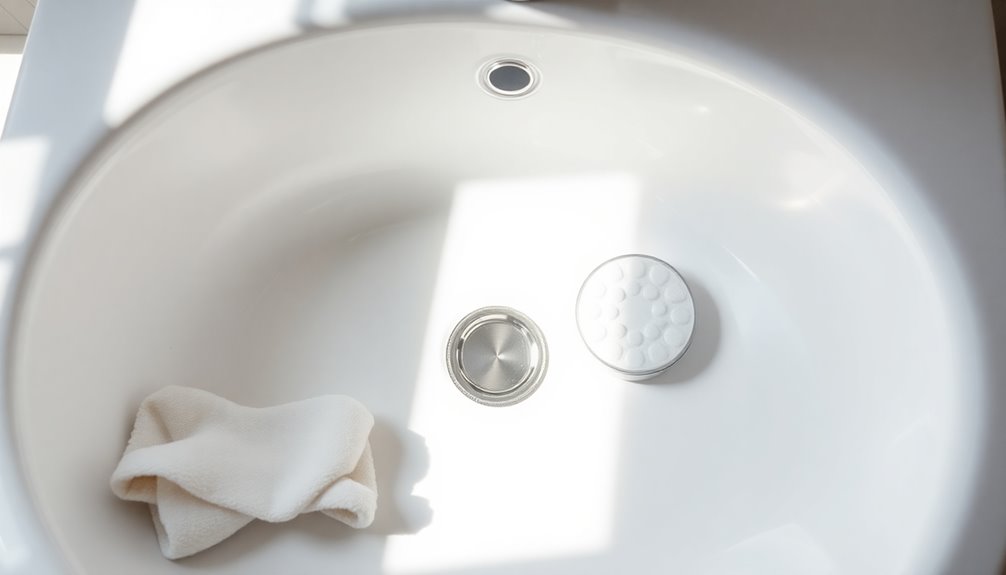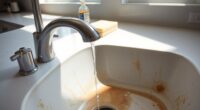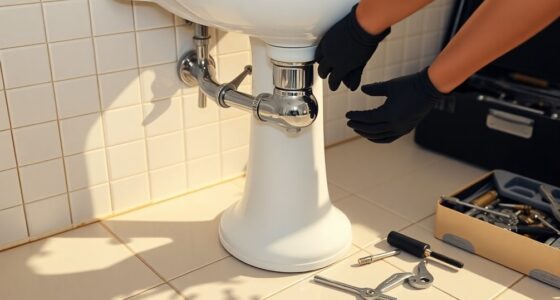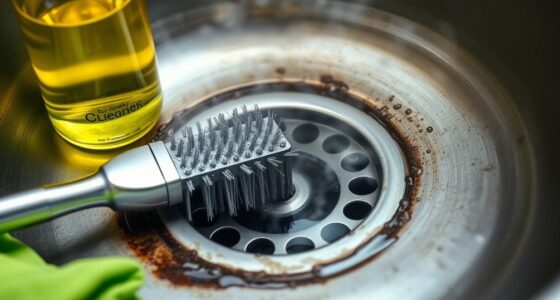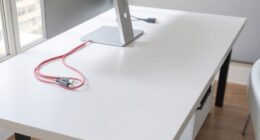To get scratches out of your porcelain sink, start by using a wet pumice stone or a baking soda paste to buff out minor scratches. For deeper ones, consider using Bar Keepers Friend or a color-matching repair solution tailored for black porcelain. Regular maintenance, like cleaning with non-abrasive cleaners and avoiding heavy objects, can help prevent future scratches. There are even more techniques and products that can help restore your sink to its original shine.
Key Takeaways
- Use a wet pumice stone to gently buff minor scratches, applying light pressure in a back-and-forth motion.
- Create a paste with baking soda and water, then buff scratched areas with a damp cloth.
- Apply Bar Keepers Friend with a soft scrubbing pad for tougher scratches, letting it sit for 10 minutes.
- Consider color-matching repair products like Porc-a-fix for nearly invisible fixes on black porcelain sinks.
- Regularly clean and maintain your sink with gentle cleaners to prevent future scratches and preserve its appearance.
Understanding the Causes of Scratches on Porcelain Sinks
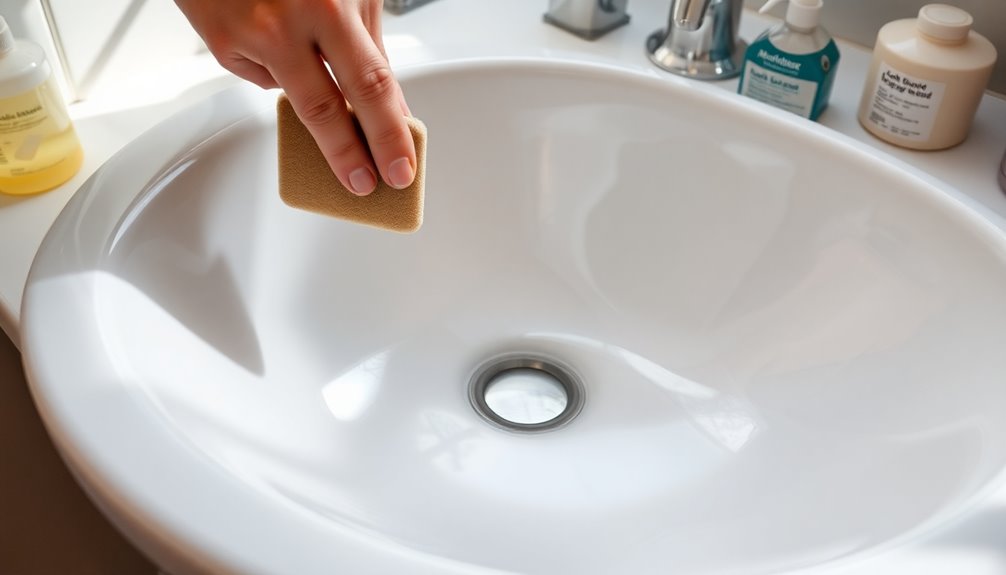
Understanding the causes of scratches on porcelain sinks is essential if you want to keep your sink looking pristine.
Everyday accessories like curling irons and blow dryers can inadvertently cause scratches from your porcelain sink when they make contact with the surface. Even though porcelain is durable, heavy objects and abrasive cleaning tools can leave nicks and marks.
Darker colored sinks, especially black, tend to show these scratches more prominently, making them a common concern for homeowners. By identifying these causes, you can adopt preventative measures, such as using soft cleaning pads and avoiding abrasive materials.
Regular maintenance and proper care can greatly extend your sink's lifespan and minimize visible scratches, helping you maintain its aesthetic appeal.
Initial Scratch Removal Techniques
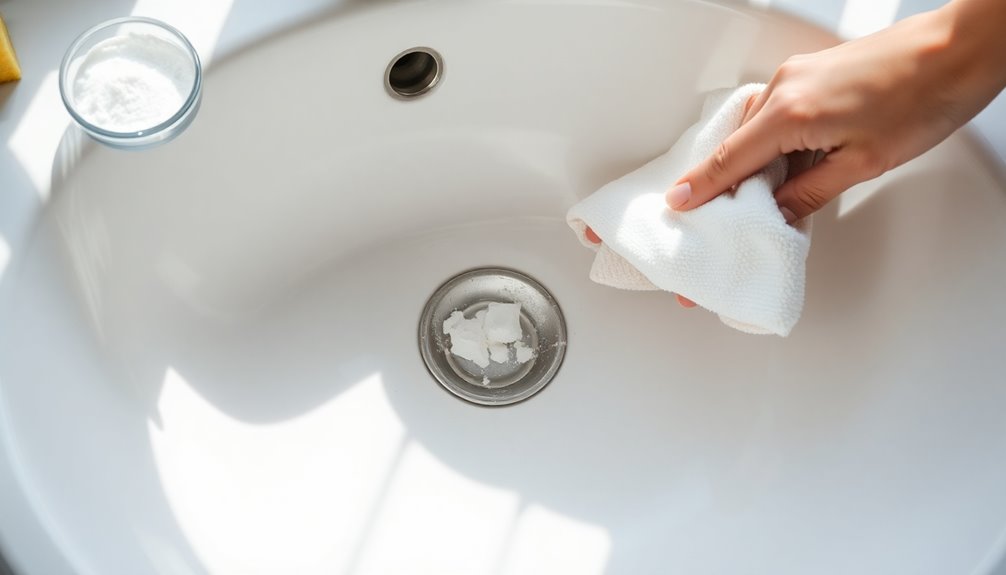
When you notice scratches on your porcelain sink, there are a few effective techniques to try right away.
Using a wet pumice stone can help smooth out minor imperfections, while a baking soda paste can tackle deeper scratches.
Additionally, a bleaching technique can enhance the overall appearance of your sink, so let's explore these methods.
Pumice Stone Application
Grab a pumice stone and get ready to tackle those scratches on your porcelain sink.
First, fill the sink with about 1/4-inch of water; this will provide lubrication and prevent further scratching. Make sure your pumice stone is thoroughly wet before you start.
Gently rub the stone over the scratched areas in a back-and-forth motion. Avoid applying too much pressure, as this could worsen the damage. The goal here is to use the pumice stone to smooth out minor nicks and scratches effectively.
After buffing the scratched areas, rinse your sink with warm tap water to remove any residue and debris. This technique works best for light imperfections, not deep gouges.
Baking Soda Method
After using a pumice stone for minor scratches, you can enhance your porcelain sink's appearance with the baking soda method.
Start by sprinkling a generous amount of baking soda directly over the scratched area. Dampen a soft cloth with water and buff the surface in a back-and-forth motion for scratches or use a circular motion for nicks. This technique helps smooth out the imperfections effectively.
Once you've finished buffing, rinse the sink thoroughly with warm tap water to remove any baking soda residue and check your results. If deeper scratches persist, consider using Bar Keepers Friend for a more powerful follow-up treatment. Regular maintenance with baking soda can also prevent future scratches, keeping your sink looking pristine.
Bleaching Technique
While it might seem unconventional, the bleaching technique can effectively tackle minor scratches on your porcelain sink. Here's how to use it:
- Fill your sink with warm water and add about two cups of bleach to create a solution.
- Let the bleach solution sit overnight; this helps lift and potentially remove those pesky scratches.
- After the soaking period, thoroughly rinse the sink with warm water to eliminate any residual bleach and protect the sink's finish.
Not only does this method target scratches, but it also disinfects and whitens your sink, making it a dual-purpose cleaning solution.
Incorporating the bleaching technique into your regular cleaning routine can help maintain your porcelain sink's appearance over time.
Utilizing Bleaching Methods for Minor Scratches

If you want to tackle minor scratches in your porcelain sink, utilizing a bleaching method can be surprisingly effective.
Start by filling the sink with warm water and adding about two cups of bleach. Let this solution sit overnight to help lift those pesky scratches and any discolorations.
By morning, you should notice improvement, as minor scratches may be considerably reduced or even removed. It's a good idea to incorporate this bleaching method into your regular bathroom cleaning routine to maintain your sink's appearance and extend its lifespan.
Remember to guarantee proper ventilation while using bleach and follow up with a thorough rinse to eliminate any bleach residue. Your porcelain sink will thank you!
Advanced Solutions: Bar Keepers Friend and Beyond
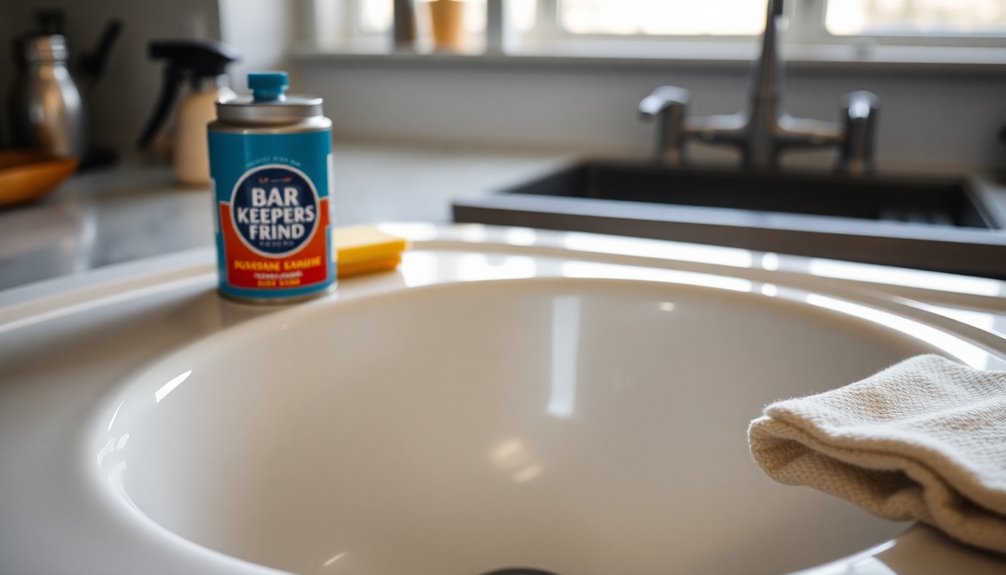
For those stubborn scratches that bleach alone can't tackle, advanced solutions like Bar Keepers Friend can work wonders on your porcelain sink.
This versatile product comes in both scouring powder and scrubbing cream forms, perfect for tough scratches. To get the best results, follow these steps:
- Wear rubber gloves to protect your hands.
- Apply Bar Keepers Friend with a soft scrubbing pad and let it sit on the scratched area for about 10 minutes.
- Consider combining Bar Keepers Friend with Dawn Dish Soap for enhanced cleaning power.
If scratches persist after using Bar Keepers Friend, you might explore other methods like baking soda or a pumice stone for additional help.
Baking Soda Solution for Surface Scratches
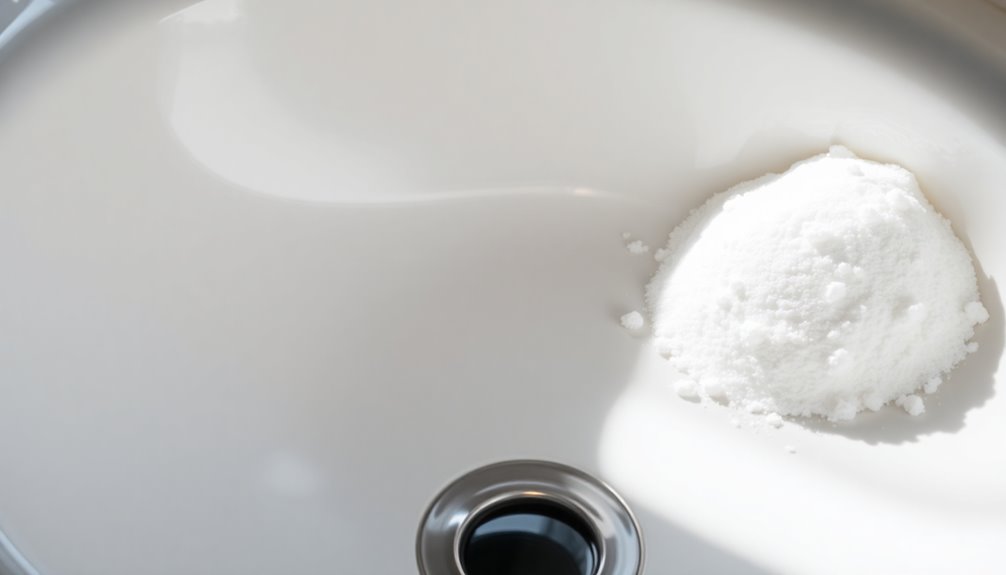
Baking soda is a simple yet effective solution for tackling surface scratches on your porcelain sink. To start, sprinkle the baking soda solution directly over the scratched area. Then, buff the scratches gently with a soft, damp cloth—use a back-and-forth motion for scratches and a circular motion for nicks. After buffing, rinse the sink thoroughly with warm tap water to remove any residue. Regular application of this baking soda solution can help maintain your sink's appearance and prevent further scratches. Here's a quick reference table:
| Step | Action | Tips |
|---|---|---|
| 1 | Sprinkle baking soda | Focus on scratched areas |
| 2 | Buff gently | Use a soft cloth |
| 3 | Rinse thoroughly | Warm tap water works best |
| 4 | Repeat regularly | Prevent future scratches |
Pumice Stone Technique for Deeper Scratches
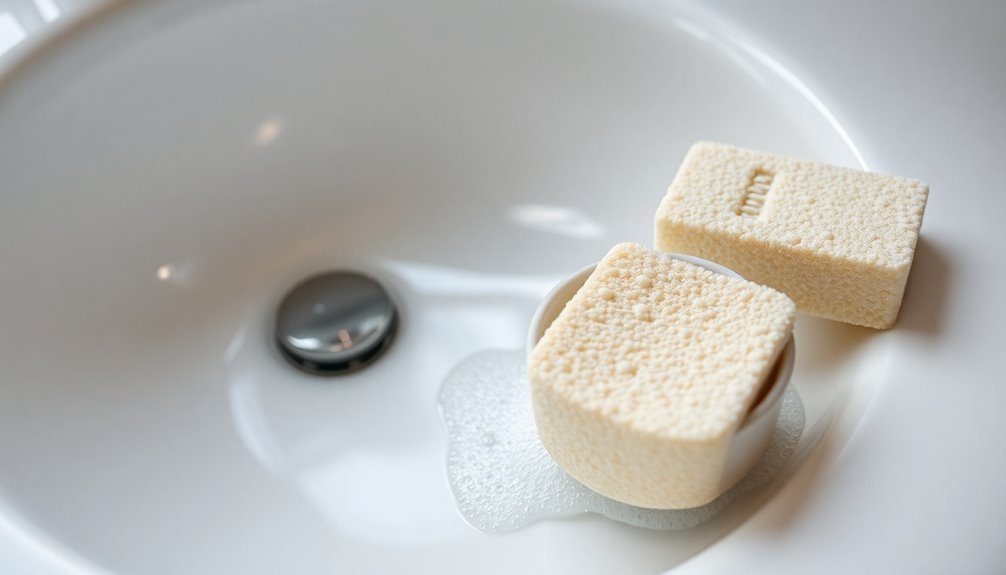
When tackling deeper scratches in your porcelain sink, using a pumice stone can be effective if done properly.
You'll want to fill the sink with about 1/4 inch of water to help lubricate the surface and prevent further damage.
However, keep in mind that this technique has its limitations and may not remove every scratch completely.
Proper Pumice Stone Use
To tackle deeper scratches in your porcelain sink, start by preparing the area with some water. Fill the sink with about 1/4 inch of water for lubrication.
Here's how to properly use a pumice stone:
- Wet the stone: Make sure your pumice stone is thoroughly wet before you begin. This softens the abrasive action.
- Scour gently: Gently scrub the scratched areas using light pressure. Focus on a back-and-forth motion to avoid damaging the porcelain.
- Rinse thoroughly: After you've worked on the scratches, rinse the sink with warm water to remove any pumice stone residue and reveal your results.
Following these steps will help you effectively use a pumice stone to minimize the appearance of deeper scratches.
Water Lubrication Importance
Using a pumice stone can greatly improve the appearance of deeper scratches in your porcelain sink, but the technique's success hinges on proper water lubrication. Water lubrication minimizes friction, preventing further scratches during your cleaning process. Start by filling the sink with about 1/4-inch of water to create a wet surface.
| Step | Action |
|---|---|
| 1. Wet the pumice stone | Saturate it before use |
| 2. Fill the sink | Use 1/4-inch of water |
| 3. Apply gentle pressure | Move the stone back and forth |
| 4. Check progress | Assess reduction of scratches |
| 5. Rinse and dry | Clean the sink after completion |
Regular water lubrication extends your sink's life by preventing new scratches. Enjoy a smoother, clearer porcelain finish!
Limitations of Technique
While the pumice stone technique can be helpful for minor scratches, it has significant limitations when it comes to deeper ones.
Here are some key points to take into account:
- Surface Level Only: This technique mainly addresses surface scratches from a porcelain sink, leaving deeper ones untouched.
- Potential Damage: Applying too much pressure or using a dry stone can worsen existing damage rather than fix it.
- Alternative Methods Needed: For scratches that penetrate beyond the surface glaze, you might need specialized repair kits or professional help to restore your sink.
To avoid deeper scratches in the future, regular maintenance and steering clear of abrasive materials are essential.
Exploring Color-Matching Repair Solutions

When you're dealing with scratches on a black porcelain sink, exploring color-matching repair solutions can be a game changer. Products like Porc-a-fix offer a range of shades designed to blend seamlessly with your sink, ensuring that repairs are nearly invisible.
These repair kits target deeper scratches that regular cleaning methods can't fix, making them essential for maintaining your sink's appearance. When choosing a color-matching repair solution, check its compatibility with black porcelain for best results.
Many products come with convenient applicators, simplifying the process so you can apply them directly to the scratches without much prep. To make the best choice, look for user reviews that highlight the effectiveness of different color-matching repair solutions available on the market.
Alternative Products for Scratch Removal
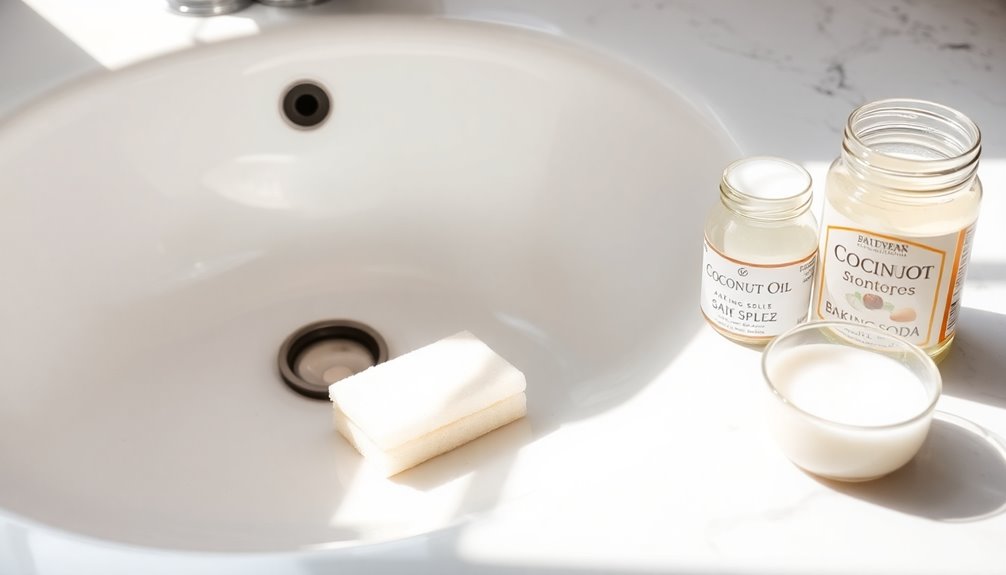
If you're looking to restore your porcelain sink's surface, several alternative products can effectively tackle scratches.
Here are three excellent options:
- Bar Keepers Friend: This cleaner works wonders for scratches. Just apply it with a soft scrubbing pad to protect your sink's finish.
- Baking Soda: Create a gentle abrasive paste by mixing it with water. Use a soft, damp cloth to buff out scratches in a back-and-forth motion.
- Pumice Stone: For minor scratches, gently scour with a pumice stone and water for lubrication.
These alternative products for scratch removal can help maintain the beauty of your porcelain sinks.
Just remember to always test any product on a small area first to guarantee it won't cause further damage.
Regular Maintenance Tips to Prevent Future Scratches

To keep your porcelain sink looking pristine, regular maintenance is key.
Start by cleaning it regularly with gentle, non-abrasive cleaners like Bar Keepers Friend or baking soda. This prevents buildup that can lead to scratches.
Always use a soft cloth or sponge instead of abrasive scrubbers, which can damage the surface. Avoid placing heavy objects or sharp utensils directly in the sink to minimize the risk of nicks.
Consider soaking the sink in a bleach and water solution overnight to maintain its finish and reduce the visibility of minor scratches.
Finally, periodically inspect your sink for any signs of wear and promptly address scratches with appropriate repair methods.
These regular maintenance tips will help prevent future scratches on your porcelain sink.
Frequently Asked Questions
Can You Remove Scratches From a Porcelain Sink?
Yes, you can remove scratches from a porcelain sink.
Start by evaluating the scratch's depth. For minor scratches, you can use baking soda or a pumice stone to buff them out gently.
If they're more stubborn, try a product like Bar Keepers Friend.
For deeper scratches, consider using a color-matched repair solution like Porc-a-fix.
Regular maintenance and avoiding abrasive materials can help keep your sink looking great and prevent future scratches.
Will Magic Eraser Scratch Porcelain Sink?
Yes, a Magic Eraser can scratch a porcelain sink if you're not careful. The melamine foam is abrasive, so you should always test it on a small, hidden area first.
If you see no scratches, apply gentle pressure while cleaning to minimize risk.
However, for regular maintenance, consider using a soft cloth or non-abrasive sponge instead, as they're less likely to damage the surface while keeping your sink clean and shiny.
How to Get Marks off a Porcelain Sink?
Imagine your porcelain sink as a canvas, marred by the occasional brushstroke of life. To get those pesky marks off, sprinkle baking soda on the area and buff gently with a damp cloth.
For tougher stains, mix baking soda with hydrogen peroxide into a paste and let it work its magic before scrubbing.
If stubborn marks cling on, a pumice stone or Bar Keepers Friend can help restore your sink's pristine glow.
How to Get Scratches Out of Sinks?
To get scratches out of sinks, start by evaluating the severity of the scratches.
For minor ones, try using a baking soda paste and buff it gently with a damp cloth.
If the scratches are deeper, consider a wet pumice stone for gentle scouring.
For tougher cases, a specialized repair kit can help restore the sink's appearance.
Always remember to avoid harsh materials that could damage your sink further.
Conclusion
To sum up, keeping your porcelain sink scratch-free is easier than you think! With just a few simple techniques, you can maintain its pristine look. Did you know that nearly 30% of homeowners experience damage to their sinks within the first five years? By following regular maintenance tips and using effective scratch removal methods, you can be part of the 70% who enjoy their sinks without unsightly marks. So, take action now and keep your sink looking fabulous!
